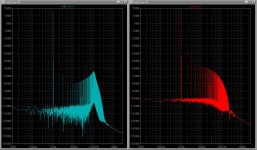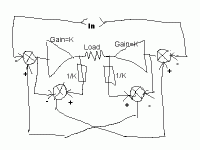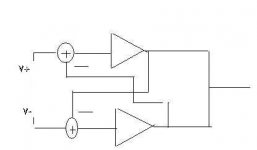Gain = X4
IMHO = In my humble opinion.
The distortion killer gives better improvements than the floating ground of the feedback.
Have to build it ASAP 😀
IMHO = In my humble opinion.
The distortion killer gives better improvements than the floating ground of the feedback.
Have to build it ASAP 😀
@ the moment I make my 4 x S1 DAC.
Distortion is not zero because it can not be.
The error amp has its own distortion and even the sim seems to know that
Distortion is not zero because it can not be.
The error amp has its own distortion and even the sim seems to know that

have you known a amp which can cancel distortion absolutely?
why don't you try to simulate with my topo or unitgain?
why don't you try to simulate with my topo or unitgain?
Because the parallel topologie is not suitable for power amplification and also the error amp got its own errors.
Amp with zero distortion does not exist. Yet 😀
Amp with zero distortion does not exist. Yet 😀
thanh said:have you known a amp which can cancel distortion absolutely?
why don't you try to simulate with my topo or unitgain?
I've tried to simulate my topo for a very basic Class B amp. It didn't work, inderstandably. When the input crosses 0V, both halves of the bridge can do very little about correcting each other's crossover distortion. It might work better in Class AB, especially if the two halves are differently biased (their xover points will be in different places so they could help each other in reducing this kind of distortion). I'll try to do Classes AB and A later.
This whole circuitry thing is kinda new to me, I'm learning my way as I go, so please bear with me if I don't make much sense.
Bernhard said:@ the moment I make my 4 x S1 DAC.
Distortion is not zero because it can not be.
The error amp has its own distortion and even the sim seems to know that
I figure that, if the error amp's distortion is level-independent at low levels (Class A?), then the sum of dB distortion figures of the main amp and the error amp will give the figure for the whole contraption, more or less.
Error amp's output is main amp's distortion plus any distortion of the error amp itself. It is subtracted from main amp's output, which leaves us with the error amp's distortion only. But since error amp's output is very small, the resulting distortion is hopefully even smaller.
Does it make sense?
unitgain said:Does it make sense?
I hope.
Main amp and error amp both are classA.
Error amp voltage swing is small.
So error amp distortion should be small also.
Error amp current swing is same as main amp.
Distortion may rise with current too 😕
As the error amp reamplifies only the distortion of the main amp, the total distortion on the load is smaller.
error amp have got its distoriton So i suggest sym topo ,
http://home.kimo.com.tw/skychutw/Circuits/Idea/X-BTL/X-BTL.html
what do you think about these topo?
http://home.kimo.com.tw/skychutw/Circuits/Idea/X-BTL/X-BTL.html
what do you think about these topo?
unnitgain,
the distortion goes up again above 10k.
This circuit which you posted may give problems because distortion is reamplified, maybe I tried that before, tried so many ...
tanh,
parallel does not work.
the distortion goes up again above 10k.
This circuit which you posted may give problems because distortion is reamplified, maybe I tried that before, tried so many ...
tanh,
parallel does not work.
Bernhard said:unnitgain,
the distortion goes up again above 10k.
This circuit which you posted may give problems because distortion is reamplified, maybe I tried that before, tried so many ...
tanh,
parallel does not work.
I think it goes up because the amp is too slow, and no good at all to begin with. The distortion should be re-amplified, but the amp does it slowly and not very accurately. With a faster amp the figure will go up too, but at much higher frequencies, perhaps 100k or more. I'll try it with other designs when I get some free time.
Also note that, though it goes up, at 20k it's still 15dB or so lower than the uncomensated figure.
thanh said:error amp have got its distoriton So i suggest sym topo ,
http://home.kimo.com.tw/skychutw/Circuits/Idea/X-BTL/X-BTL.html
what do you think about these topo?
This is basically equivalent to my topo, only simpler. But mine can be used with an existing amp when you can't access its feedback circuit.
the distortion output is the distortion of error amp if the cancelling is absolute.But the error amp is also normal amp so it also has got distortion .I want a topology which can cancel the distortion of the error amp
I think there is a killer amp on simulated sofware.There is not a killer amp in the real world .Because components are different or not similar.
If the future amp operate in class A,i will put it into rubbish bin and i don't need the feedforward .Because it is so hot
I think there is a killer amp on simulated sofware.There is not a killer amp in the real world .Because components are different or not similar.
If the future amp operate in class A,i will put it into rubbish bin and i don't need the feedforward .Because it is so hot
bernhard,can't you post your topo?
I think " dreamed topo is su-sy".I don't like class A.So I intend to fig a su-sy which operate in class AB
I think " dreamed topo is su-sy".I don't like class A.So I intend to fig a su-sy which operate in class AB
- Status
- Not open for further replies.
- Home
- Amplifiers
- Solid State
- no mercy distortion killer circuit


